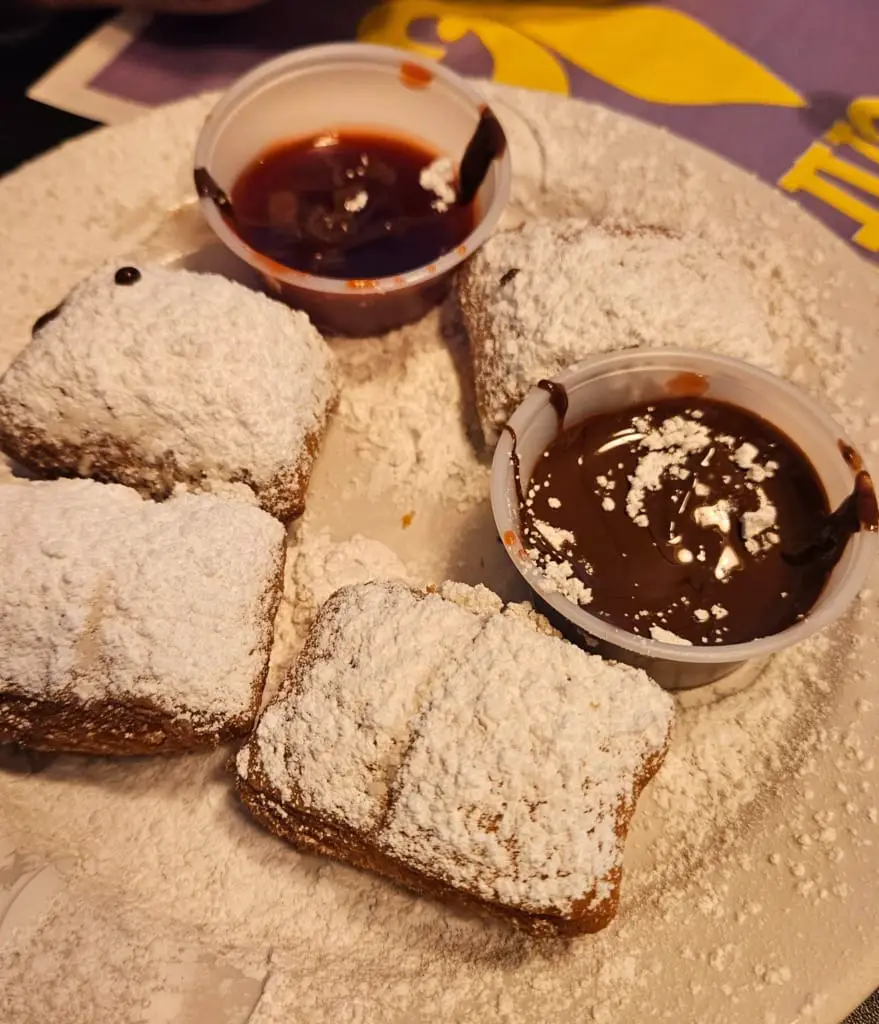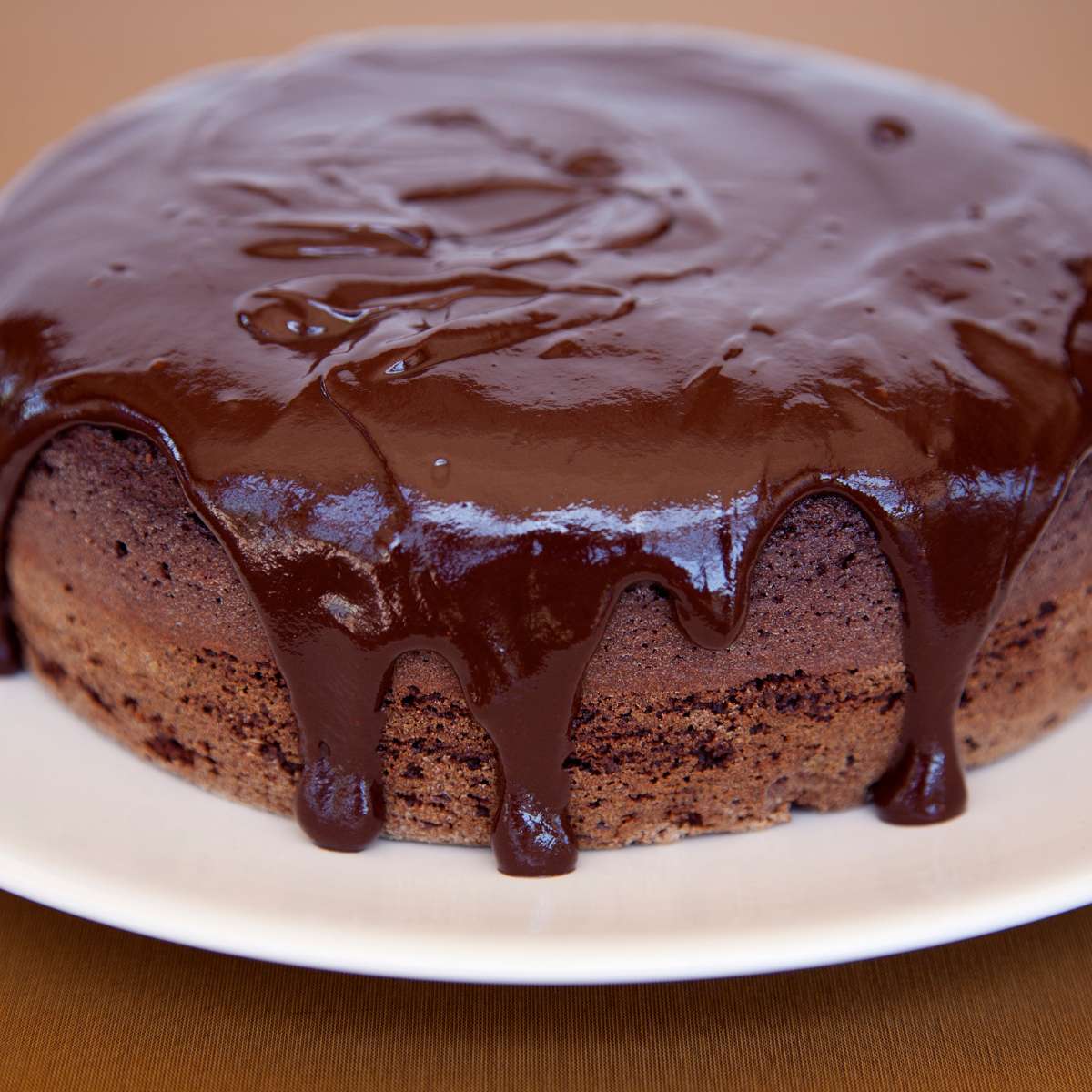What is Ganache? Imagine a world where chocolate frosting, chocolate filling, truffle making, and dessert topper are all encapsulated in one heavenly creation. Enter the versatile chocolate ganache. Stemming from French dessert techniques, ganache is a luxurious blend of chocolate and cream that has won the hearts (and taste buds) of dessert enthusiasts everywhere.
Keep reading to uncover the secrets to making perfect ganache, learn about different variations, and discover tips on how to store and troubleshoot this essential confectionery component.
What is Ganache?
Ganache is a creamy mixture of chocolate and cream, often used as a filling or topping in various desserts. It’s made by gently heating cream and pouring it over chopped chocolate, then stirring until smooth and silky. The simple ingredients and preparation method make ganache incredibly versatile.
It can be poured as a glaze, whipped as a frosting, cooled and shaped into truffles, and is perfect as a rich dip for fruits or pastries. This makes ganache a popular choice for adding rich, chocolatey goodness to various dessert recipes.
Exploring the Origins and Pronunciation of Ganache
Ganache is a staple in the world of French desserts, born from what seemed like a culinary blunder. The term “ganache” originated from the French word “la ganache,” meaning a fool or simpleton.
According to culinary lore, the creation of ganache was accidental, occurring when a chocolatier’s apprentice mistakenly poured hot cream over some chocolate pieces. The master chocolatier initially rebuked his apprentice by calling him a “ganache,” only to realize that this mishap had resulted in something deliciously rich and creamy.
The correct pronunciation of ganache, adhering to its French roots, is either /ɡəˈnaSH/ or /ɡæˈnaʃ/. This creamy chocolate mixture has since evolved into a versatile ingredient in many desserts and pastries, from chocolate cakes to chocolate croissants.
Choosing the Right Chocolate for Ganache
The type of chocolate you use will significantly influence both the flavor and texture of your ganache. While you don’t necessarily need to break the bank, opting for good-quality chocolate truly makes all the difference.
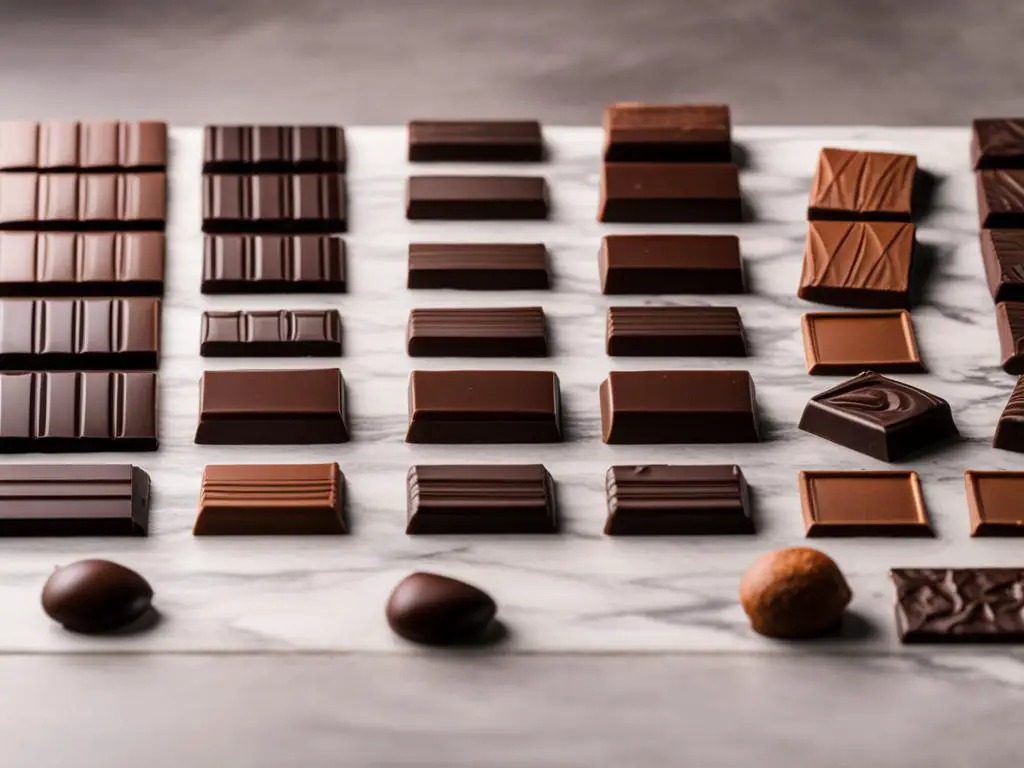
When it comes to choosing the best chocolate for your ganache, chocolate bars are a better option than chocolate chips due to the absence of shape-preserving additives. Here are the main types of chocolate you can use:
- Milk Chocolate: Contains 10–20% cocoa and offers a subtle cocoa taste with a more pronounced sweetness. It’s great for those who prefer a milder chocolate taste.
- Semi-sweet chocolate: Recommended for traditional ganache, semi-sweet chocolate generally falls within the 35–45% cacao range, offering a well-balanced blend of sweetness and dark flavors.
- Bittersweet chocolate: With a cocoa percentage of about 60%, bittersweet chocolate delivers a more intense chocolate experience without diminishing the cream’s delicate nuances.
The percentage of cocoa in chocolate affects its taste, aroma, and texture. Higher cocoa content means a more intense chocolate taste and less sweetness, which can enhance the sophisticated profile of your ganache.
Choosing the Right Cream for Ganache
Selecting the right cream is just as crucial as the chocolate in making a perfect ganache. The type of cream you use greatly affects the ganache’s flavor, texture, and overall consistency, playing a vital role in the dessert’s success.
Why Heavy Cream Makes the Difference
Heavy whipping cream is the secret weapon of ganache perfection. Its high fat content contributes to the rich, smooth texture that sets ganache apart from other chocolate desserts. When heated just until simmering, heavy whipping cream reaches the ideal temperature for melting the chocolate without boiling over, ensuring a seamless blending process.
By using this luxurious ingredient, you give your ganache the best chance to meld harmoniously with your chosen chocolate, producing a velvety confection unlike any other.
Alternative Creams for Dietary Restrictions
For those with dietary restrictions, there are several non-dairy alternatives that still achieve a delicious ganache:
- Coconut Milk: Canned coconut milk is a popular choice for its thick, creamy texture that mimics heavy cream.
- Almond Milk: While thinner, almond milk can be reduced slightly to mimic the creaminess needed for ganache.
- Soy Cream: Soy cream is another great alternative, offering a richness similar to dairy cream.
- Cashew Cream: Homemade cashew cream, made from blended cashews and water, provides a rich, neutral base that works well in ganache.
Each of these alternatives offers a unique flavor and consistency, and while they might slightly alter the taste compared to traditional ganache, they provide delicious options that cater to various dietary needs.
The Perfect Ganache Ratio
Achieving the perfect ganache consistency requires careful attention to the chocolate-to-cream ratio. This ratio fluctuates based on the intended use, from thin glazes to thick fillings. For a standard ganache that sets properly, an equal weight of chocolate to cream is commonly recommended.
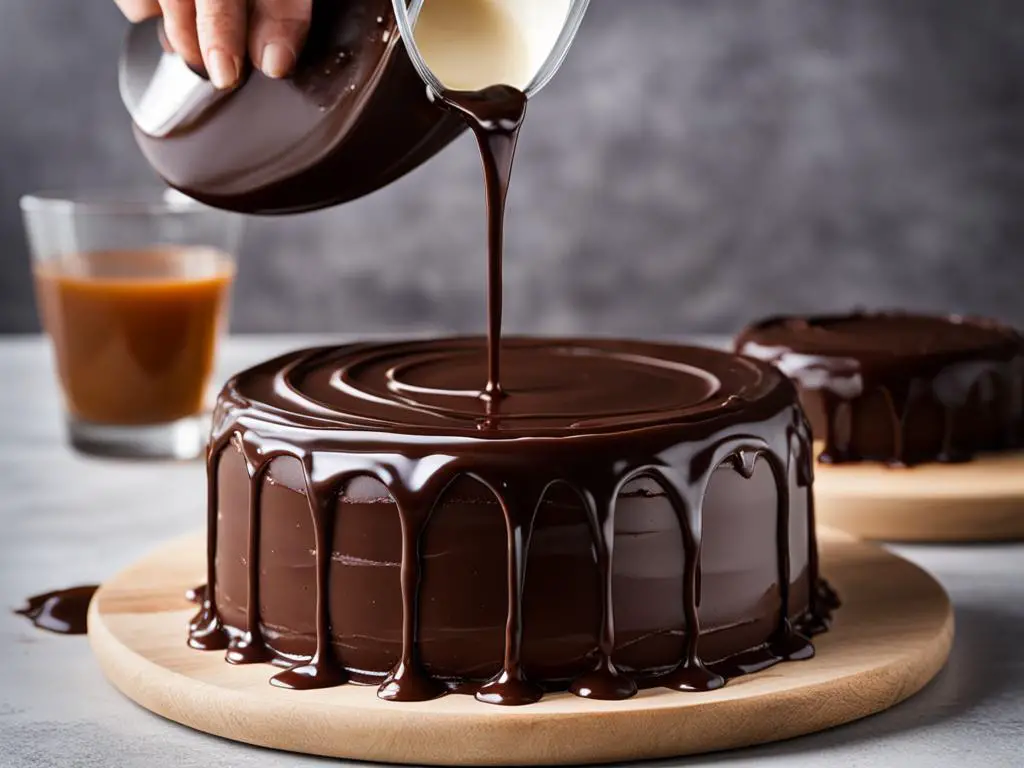
However, adjustments may be necessary when dealing with various types or qualities of chocolate. The rule of thumb is that too much cream results in a sauce, while excess chocolate leads to a firmer set, ideal for truffle centers or sculptable toppings.
Let’s explore some of the most common ganache scenarios and their recommended ratios:
| Type of Ganache | Chocolate to Cream Ratio | Setting Ganache |
|---|---|---|
| Thin Glaze | 1:2 | Chill for 10 minutes before applying |
| Standard (frosting, filling, or topping) | 1:1 | Refrigerate for 30 minutes, then whip to desired consistency |
| Truffle Centers | 2:1 | Refrigerate for at least 2 hours, then scoop or cut into desired shapes |
| Sculptable Topping | 3:1 | Chill for at least 4 hours or until firm, then shape as desired |
How to Make Ganache
Creating the perfect ganache is a culinary art that requires precision and patience. It can be made using traditional stovetop methods or with the convenience of a microwave. Both techniques can produce a luscious, smooth blend ideal for various desserts.
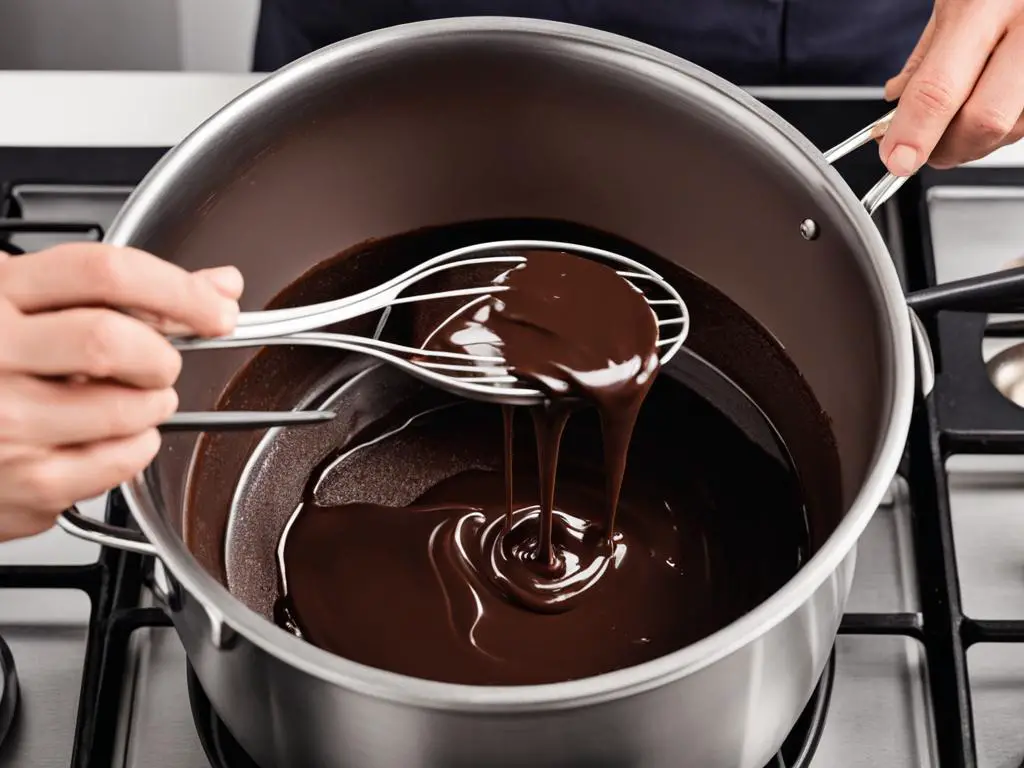
Traditional vs. Microwave Method
Here’s how to prepare ganache using both methods:
Traditional Stovetop Method:
- Finely chop the chocolate to ensure it melts evenly.
- Gently heat heavy cream in a saucepan over medium-low heat until it simmers. Be careful not to let it boil.
- Pour the warm cream over the chopped chocolate and let it sit for a minute.
- Stir the mixture until it becomes fluid and homogeneous.
Microwave Method:
- Chop the chocolate into small, even pieces and place them in a microwave-safe bowl.
- Heat heavy cream in the microwave for about 45 seconds to 1 minute or until it simmers.
- Pour the heated cream over the chocolate, let it rest for a moment, then whisk together until smooth and creamy.
Tips for Ensuring a Smooth and Even Blend
Regardless of the method you choose for ganache preparation, the key to success lies in properly combining the chocolate and cream. To achieve a smooth and even blend, follow these essential tips:
- Avoid boiling the cream; a gentle simmer is enough to melt the chocolate without burning it.
- Allow the cream and chocolate to rest before mixing, which helps soften the chocolate and facilitates easier blending.
- Use a rubber spatula or whisk to stir the ganache, working from the center outward to ensure a smooth consistency.
- Exercise patience when preparing ganache, as it may require a bit of time for the cream to fully incorporate with the chocolate.
By mastering these techniques and tips, you can create a delectable ganache for any dessert, from lavish cakes and pastries to delightful truffles and glazes.
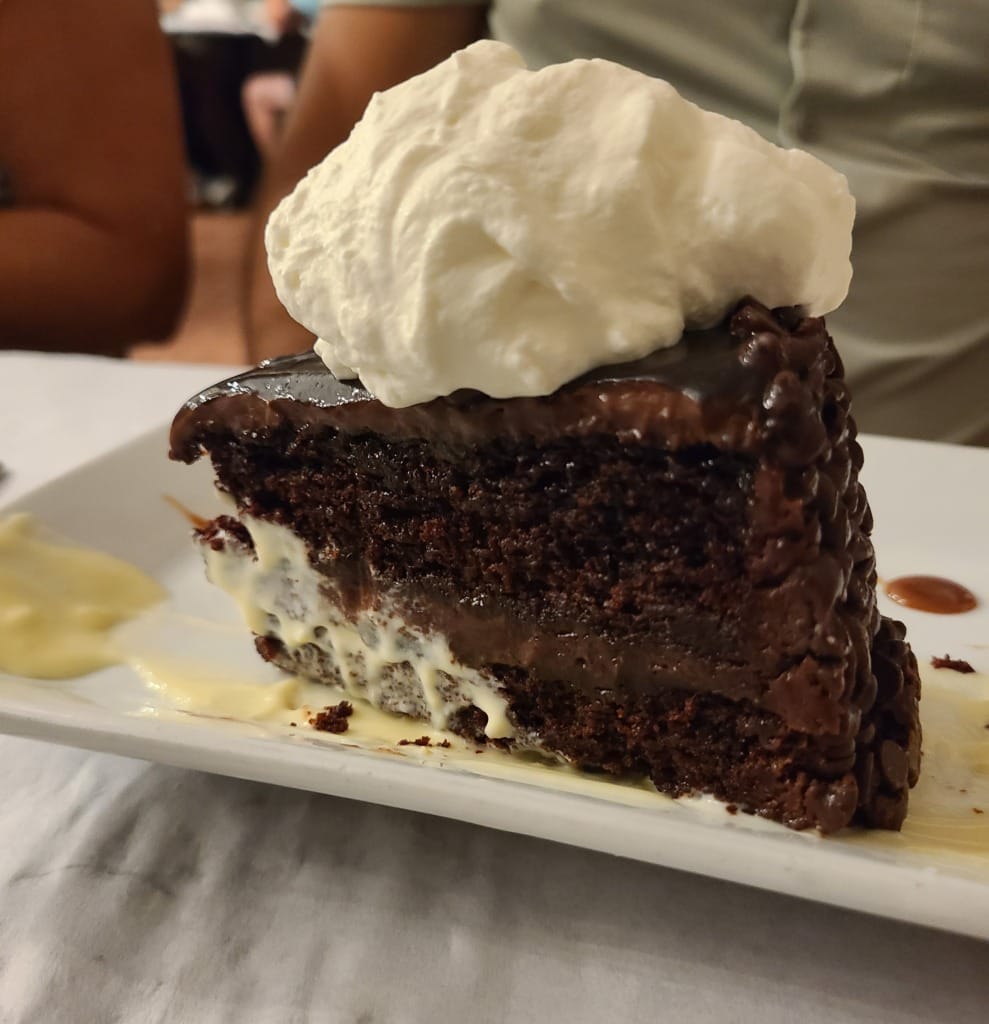
Creative Ways to Enhance Your Ganache
Ganache customization is an exciting way to enhance the overall taste and aesthetic appeal of your desserts. Experimenting with a range of flavor infusions, from fruit ganache variations to exotic ganache flavors, can take your ganache to the next level. Here are some practical ideas for adding unique twists to your ganache:
- Fruit Purees and Extracts: Enhance your ganache with fruit flavors like raspberry, strawberry, or mango by mixing in fruit purees or extracts when blending the chocolate and cream.
- Powdered Sugar: For a sweeter ganache or to adjust the consistency slightly, add a little powdered sugar. This can also help thicken the ganache if it’s too runny, especially when you want a firmer texture for decorating.
- Spices: Add warmth and depth with spices such as cinnamon, nutmeg, or cardamom.
- Nuts: For a richer taste, stir in Nutella, peanut butter, or almond butter into your ganache.
- Liqueurs: Incorporate a sophisticated touch with a splash of orange liqueur, coffee liqueur, or Irish cream.
When adding these flavor infusions to your ganache, be sure to start with small quantities and increase incrementally, tasting as you go. This ensures that your resulting ganache showcases a delicious synergy of flavors, with just the right level of sweetness and complexity.
Ganache Troubleshooting: Fixes for Common Issues
From grainy textures to split mixtures, encountering challenges while crafting ganache is not uncommon, but don’t worry—most issues have simple fixes. Here are some tips to help you solve common ganache problems:
- Too Thick: If the ganache is thicker than you’d like, gradually stir in warm cream until it reaches your desired consistency.
- Grainy Ganache: If your ganache looks grainy, gently reheat it over low heat, stirring slowly until the texture becomes smooth.
- Split or Oily: For ganache that has split or appears oily, slowly mix in a small amount of warm milk using an electric mixer to emulsify and smooth out the mixture.
- Preventing Overheating: To avoid overheating your chocolate, melt it using a double boiler. This indirect heat method allows for more even melting.
These troubleshooting tips can help you salvage and perfect your ganache, ensuring your dessert finishes smooth and delicious every time.
Storing Your Ganache
On average, homemade ganache can last up to five days in the refrigerator without any decline in quality. To ensure successful ganache preservation, always store it in an airtight container to prevent exposure to moisture and odors. When you’re ready to re-use your ganache, simply allow it to return to room temperature and give it a gentle stir for a smooth, velvety texture.
For longer storage, adding preservatives like glucose or sorbitol can help maintain its creaminess, though they may slightly change the flavor. Alternatively, using inverted sugar as a preservative can extend the shelf life without overly sweetening the ganache, preserving its delightful taste and texture.
Conclusion
Ganache is more than just a mixture of chocolate and cream; it’s a cornerstone of fine pastry making. Its ability to transform simple ingredients into a sumptuous, silky-smooth concoction makes it a favorite among dessert lovers. Whether you use it as a filling, a glaze, or a frosting, ganache adds a touch of indulgence to any treat.
Remember, the key to perfect ganache lies in the quality of chocolate and the precision in preparation. With the tips and techniques discussed in this article, you’re now equipped to master the art of ganache, ensuring that your next dessert not only tastes divine but also looks professionally made.
FAQ
Can ganache be used as a cake frosting?
Absolutely! When cooled and whipped, ganache can become fluffy and spreadable, making it an excellent choice for frosting cakes. For an even lighter texture, you can fold in some Chantilly cream, which will add a delicate sweetness and airy quality to the rich chocolate flavor of the ganache. This combination creates a luxurious frosting that’s perfect for special occasion cakes.
Is ganache gluten-free?
Ganache is naturally gluten-free as it typically contains only chocolate and cream. However, always check the labels of your ingredients to ensure they haven’t been processed in facilities that handle gluten.
How long does ganache take to set?
Ganache typically takes about 2 hours to set at room temperature. If you’re in a hurry, you can speed up the process by chilling it in the refrigerator.
Can ganache be frozen?
Yes, ganache can be frozen for up to a month. Make sure to store it in an airtight container. Thaw in the refrigerator overnight before use.
Why did my ganache split?
Ganache can split if the cream is too hot when added to the chocolate or if it’s mixed too vigorously while still hot. To fix the split ganache, gently reheat and add a small amount of warm cream, then whisk until smooth.

